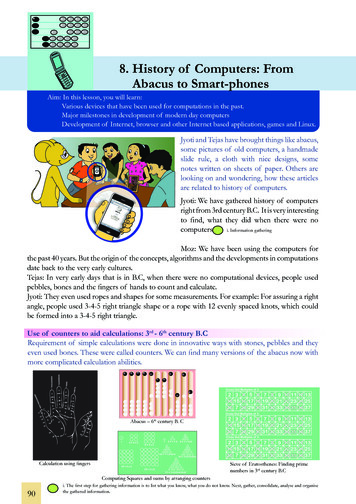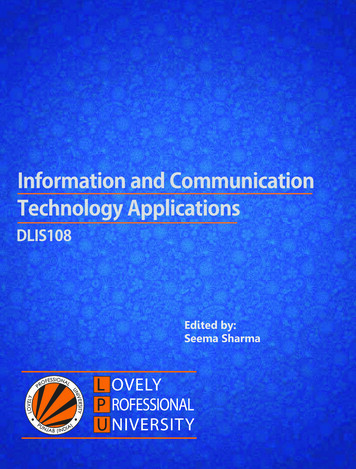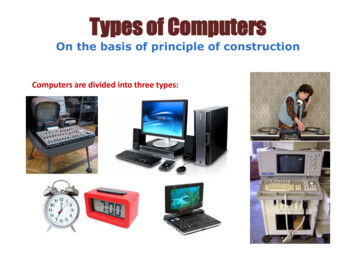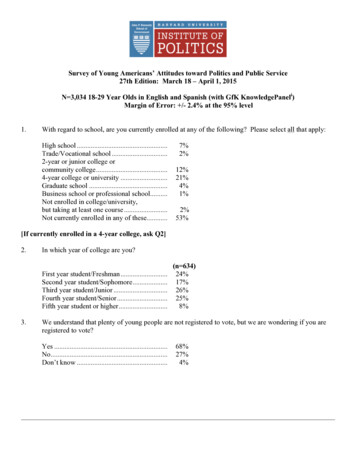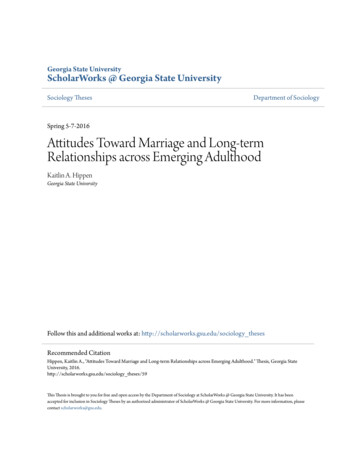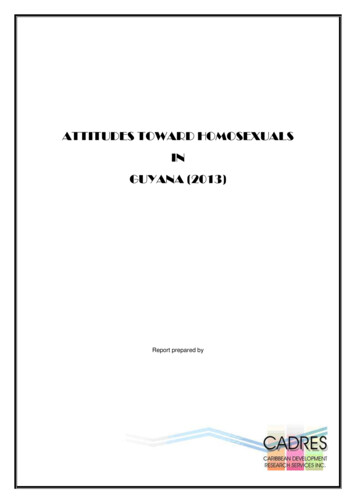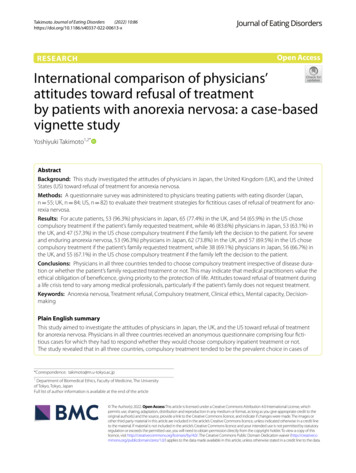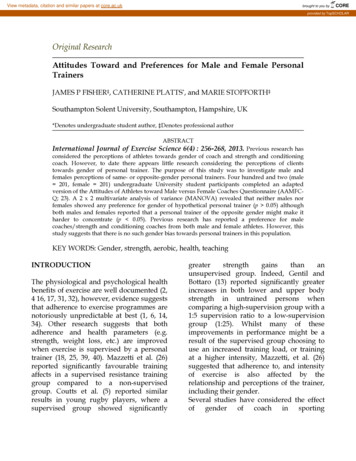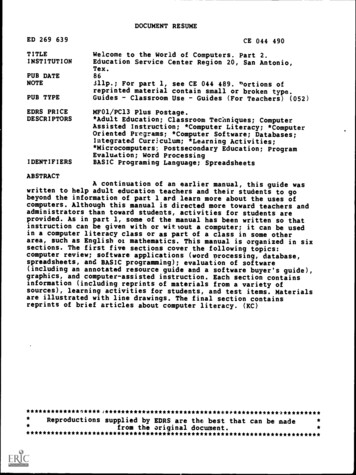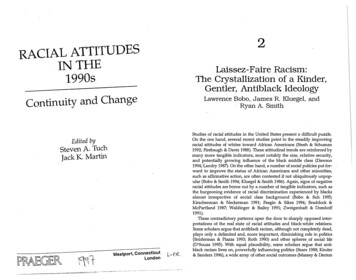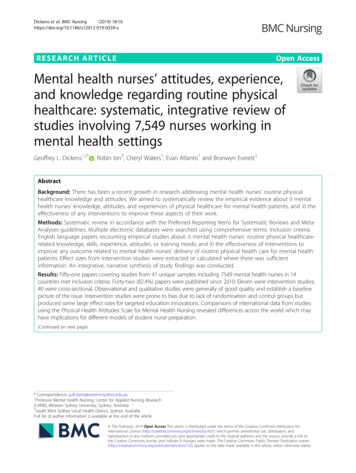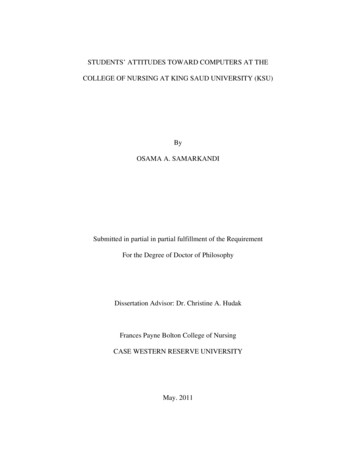
Transcription
STUDENTS’ ATTITUDES TOWARD COMPUTERS AT THECOLLEGE OF NURSING AT KING SAUD UNIVERSITY (KSU)ByOSAMA A. SAMARKANDISubmitted in partial in partial fulfillment of the RequirementFor the Degree of Doctor of PhilosophyDissertation Advisor: Dr. Christine A. HudakFrances Payne Bolton College of NursingCASE WESTERN RESERVE UNIVERSITYMay. 2011
CASE WESTERN RESERVE UNIVERSITYSCHOOL OF GRADUATE STUDIESWe hereby approve the thesis/dissertation of:Osama Abdulhaleem SamarkandiCandidate for thePhDDegree *.Christine A. Hudak, PhD, RN, M.Ed., CPHIMS(Chair of the committee)May L. Wykle, PhD, RN, FAAN, FGSA(Committee member)Faye A. Gary, EdD, MS, RN, FAAN(Committee member)Alan F. Dowling, Ph.D.(Outsider committee member)Date: 11/05/2010*We also certify that written approval has been obtained for anyproprietary material contained thereini
DEDICATIONFirst and foremost, I thank Allah (The God) for giving me the ability, opportunity,and strength to complete my PhD studies at Case Western Reserve University. To mybeloved parents, for preparing me to be a productive citizen in the Saudi society as well asother communities throughout the world. They always loved, supported, and helped me in allof my endeavors, and I am grateful to my beloved wife, Eman, and our wonderful children,Lujain, Waleed, and Lamar, I wish to thank them for adding so much value to my life andencouraging me to excel, even when it meant that the time we would have had togetherwould be shortened. They are the winds beneath my wings. They are my jewels and thecenter of my lifeii
Table of ContentsTitlePageDedication . .iiTable of content . . .iiiList of Tables . . .viiiList of Figures . . ixAcknowledgments . . . xAbstract . . . .xiChapter I . . . 1Introduction . . 1Purpose of the Study . . 4Statement of the Problem . . 5Significance of the Study . . . 6Research Questions . . 7Theoretical and Operational Definitions of Study . 8Computer, Theoretical Definition . . 8Computer, Operational Definition . . 8Attitude, Theoretical Definition . 8Attitude, Operational Definition . 9Anxiety, Theoretical Definition . . 9Anxiety, Operational Definition . 9Computer Confidence, Theoretical Definition . . 10Computer Confidence, Operational Definition . 10iii
TitlePageComputer Liking, Theoretical Definition . . 10Computer Liking, Operational Definition . . 10Computer Usefulness, Theoretical Definition . 11Computer Usefulness, Operational Definition . . 11Computer Attitudes Scale (CAS) . 11Chapter II . . . .12Literature Review . 12Computers in Baccalaureate Nursing Education . . . 12Computer Usage in Nursing Education in Saudi Arabia . . 14New Opportunities for Advanced Education . 17Attitudes toward Computers . 17CAS Studies in the World Community . . 23Theoretical Model . 30Chapter III . . .36Research Methodology . 36Setting . 36History of Saudi Arabia . 38Design . 41Sample . . 41Instruments . 42Demographic Questionnaire . . 42Computer Attitude Scale (CAS) . . 42iv
TitlePageValidity and Reliability of the Measures . . 46Sample Size Calculations . . 47Data Collection Procedure . 49Plan for Data Analysis . . 51Research Question One . . 52Data Analysis Plan for Question One . . 52Research Question Two . 52Data Analysis Plan for Question Two . . 52Research Question Three . 52Data Analysis Plan for Question Three . 53Research Question Four . 53Data Analysis Plan for Question Four . . 53Research Question Five . 53Data Analysis Plan for Question Five . . 53Limitations of the Study . 54Data Organization and Tracking . . 55Data Storage and Safety . 55Implication of Research for: . 56Administration . 56Education . 57Practice . 57Research . 58v
TitlePageHealth Policy . 59Chapter IV . . 60Data Analysis . . .60Findings . . . 62Question One . . 62Question Two . . 64Question Three . . .64Question Four . . 65Question Five . . 66Chapter V . . .67Conclusion and Recommendations . 67Question One . . .67Question Two . . 68Question Three . . . 69Question Four . . 70Question Five . . 72Summary of Research Questions . . 72Implications and Recommendations . 73Nursing Administration, Implications . . 73Nursing Administration, Recommendations . 74Nursing Education, Implications . 74Nursing Education, Recommendations . 75vi
TitlePageNursing Practice, Implications . 75Nursing Practice, Recommendations . 76Nursing Research, Implications . 76Nursing Research, Recommendations . . 77Conclusion . . . 78Appendix . 79A, Diagram 1, Data collection procedure . .79B, Consent Form . . 81C, Consent Form (Arabic Version) . .85D, Measurement Tool (CAS) . . .87E, Measurement Tool (CAS, Arabic Version) . . . 91F, Authors’ Husband Permission to Use (CAS) . . .95G, KSU IRP Approval . . . .98H, CWRU IRP Approval . . .102I, Codebook . . . 105Reference . . .vii116
List of TablesTable 1: The Four Subscales and the associated items on the CAS Questionnaire 11Table 2: The four elements of attitude. Loyd & Gressard (1985) .22Table 3: Positively and Negatively Worded Items on the CAS Measure .44Table 4: The Four Subscales on the CAS (Loyd & Gressard, 1987) .44Table 5: Study Variables, Description of Demographic Questioner Instruments,Levels of Measurement, and Four Subscales in the Study .45Table 6: Study Variables, Description of CAS Instruments, Levels of Measurement,and Four Subscales in the Study . .46Table 7: Cronbach’s Alpha Values for the Previous Studies (Total & Subscale) .47Table 8: Previous Study Statistics, Effect Sizes, Statistical Tests, and Sample Sizes 49Table 9: Comparison between Previous-Study Statistics, Effect Size, Statistical Tests, 61and Sample Size . . Table 10: Comparison between Cronbach’s Alpha Values of the Previous Studies(Total and Subscale) and the Current Study .61Table 11: Descriptive Statistics of study variables . . 63Table 12: Means Difference for gender-male and female .64Table 13: Correlation of Students Attitudes with Independent Variables . 65viii
List of FiguresFigure 1: Bandura's model of Reciprocal Determinism. . 32Figure 2: Concept of the study . .35Figure 3: Saudi Arabia Population Pyramid for2000, (Nation Master, 2005) . 37Figure 4: Saudi Arabia Population Pyramid for2005, (Nation Master, 2005) . 37Figure 5: Saudi Arabia Population Pyramid for2010, (Nation Master, 2005) . 38Figure 6: Map of Saudi Arabia . .ix39
ACKNOWLEDGMENTSI would like to take this opportunity to express my appreciations to my committeechair, Dr. Christine Hudak, the Director of NurseWeb at the Frances Payne Bolton School ofNursing at Case Western Reserve University. During my PhD journey Dr. Hudak dedicatedand sacrificed her time to make this journey fruitful, and to make my academic dreams cometrue.I would like also to thank Dr. May L. Wykle, Dean and Florence Cellar Professor ofNursing at the Frances Payne Bolton School of Nursing at Case Western Reserve University,and President of the Honor Society of Nursing, Sigma Theta Tau International, for heracademic support through my academic journey.I am deeply grateful for Dr. Faye Gary, Medical Mutual of Ohio Kent W. Clapp Chairand Professor of Nursing, and Frances Payne Bolton School of Nursing's first AssociateDean for Minority Affairs and Health Disparities for encouraging me, and making it possiblefor me to attain my academic goals - receiving my PhD at this outstanding University. I amalso indebted to her for her constant encouragement, the valuable suggestions for myresearch, and the generous sharing of her time and expertise through the course of myacademic studies.Special thanks are also owed to Dr. Alan Dowling, the Chief Executive Officer of theAmerican Health Information Management Association (AHIMA), for his crucial advice inrelation to the implementations of the Electronic Health Record (EHR), to the current healthinformatics trends, and literatures in support of this dissertation.Finally, the Sigma Theta Tau International, Alpha Mu Chapter provided financialsupport for this research. I am grateful to them for their generosity.x
Students’ Attitudes toward Computers at theCollege of Nursing at King Saud University (KSU)AbstractByOSAMA A. SAMARKANDIComputer knowledge and skills are becoming essential components technology innursing education. Saudi nurses must be prepared to utilize these technologies for theadvancement of science and nursing practice in local and global communities.Little attention has been directed to students’ attitudes about computer usage inacademic communities in Saudi Arabia. Their attitudes about the use of computers for theenhancement of learning are relatively unknown. Few research studies have been identifiedthat explicate Saudi Arabian nursing students’ attitudes toward computer usage for theacquisition of knowledge and skills.Males and females matriculate at King Saud University (KSU), but attend classes ingender-specific groups. This descriptive correlation study will contribute to the body ofknowledge related to nursing students’ attitudes toward computer usage in theirbaccalaureate education at KSU. The research included all students enrolled in the College ofNursing at KSU in Riyadh, in the summer semester of the academic year 2009/2010. Thetotal number of undergraduate nursing students were 600; 195 were males and 405 werefemales (KSU, 2008).The findings (n 335; nm 133 & nf 222) suggest that females were more anxiousxi
about computer usage (Mean 31.53; 32.7) than males. None of the independent variablesexplained the variance in the dependent variable, computer usage. Findings did indicate thatstudents had less anxiety if they had access to a computer at home or at school; their anxietywas even less if they had computer exposure at both home and school. Implications of thesefindings are presented with regard to educating future nurses at KSU for complex roles inhealth care systems. The study also raises issues about the possibility of planningintervention studies for future research about computer learning, possibly using simulationbased approaches and virtual systems. Issues regarding gender, socioeconomic status, age,learner attitudes, and other variables will need to be systematically investigated. Futurestudies should assist with the unraveling of traditional cultural issues, including genderspecific roles and expectations for computer usage in nursing and health care delivery.xii
1Chapter IIntroductionSaudi Arabia is the fastest growing developing country in the Arab world. It isranked 20th in the global economy and has an economic base that sustains itsdevelopment. This overall development was created by the discovery of oil in the late1930s (Marrone, 1999). In the early 1940s, the Saudi government began planning for thecreation and development of the country’s infrastructure and proceeded to address themost fundamental concerns of its people. Included in its strategies for development werekey areas that could impact the nation’s people: education, health, transportation,agriculture, and industry were the topics of greatest concern. As a result of the overalldevelopment of the country and the insight to implement the use of computers in dailylife, the Saudi government explored the utility of this novel technology. Over the years,Saudi society has been increasingly supportive of and transformed by a wide variety ofcomputer technologies that it uses. As a result of the government’s emphasis ontechnology, Saudi Arabia has become a technologically oriented nation, where computerscan be found almost anywhere including the homes of the Saudi people. As computertechnology has grown and developed, the Saudi government has also realized thepotential benefits of computer technology in education. Hence, all schools in SaudiArabia are being equipped with computers, and children and youth are beginning tomaster the available technology. School systems are developing and enhancing computerliteracy programs that will help teachers, students, and others to utilize this technology ina variety of educational settings.
2It is anticipated that teaching and learning at all levels in society will be impactedby innovations that are associated with computer technology. The profound potential thatis related to the use of computers will overlap all aspects of human life. Computertechnology will also link Saudi Arabia to other Arab countries as well as every country inthe global community (Al-Farsi, 2001; Mufti, 2002).Technology usage is an important component of health care planning anddelivery. Its use is moving at a phenomenal rate. Technology will impact Saudi society ina way that is similar to its influence on other world communities. Specifically,technology will help the Saudis to increase their research efforts at the molecular levelsof scientific investigations (e.g., genetics). It is an essential tool for conductingepidemiological research and for implementing community-based research in largepopulations. Computer technology will enable Saudi scientists and clinicians toparticipate in research on the world stage and reduce costs by utilizing resources forimplementing health care that are available in other global communities. Importantly, theuse of technology will enable the Saudi people to generate and utilize evidence-basedpractice approaches to health care, expand research, and generate new knowledge that isspecific to the Saudi people. These novel approaches that are available because oftechnology also have challenges. The Saudi government, like other governments in theworld community, will need to give in-depth consideration to technology-related issuessuch as confidentiality and ethical decision making. Nevertheless, the advantages oftechnology in Saudi Arabia have been embraced by the society and government. Allhealth care providers are expected to become computer literate and utilize technology intheir practice, research, and education and training (McLaughlin et. al , 2008).
3It is crucial that Saudi nurses be prepared with the knowledge and skills that areessential for providing quality care in Saudi Arabia and the world community. Computerknowledge is fast becoming an essential work-related skill. The use of technology innursing education is a relatively new and novel phenomenon. From the beginning of thehigh technological orientation in health care in the 1970s to the personal computer in the1980s and the Internet boom of the 1990s, technology usage has impacted nursingeducation dramatically (Mallow & Gilje, 1999). In response to this trend, the College ofNursing at King Saud University (KSU) has initiated a requirement that all students mustsuccessfully complete an introductory computer class (Tech 227). This requirementbegan about 15 years ago. This mandatory two-credit-hour course consists of face-to-faceclassroom lectures and additional laboratory-based practice with computers. Toaccommodate the needs of students, and, at the same time, facilitate their acquisition ofskills, the college has equipped two laboratories with 40 computers.These technological advances have assisted the students by enhancing theirlearning. One practice, however, remains constant. Although the University invites malesand females to its campus, the religious and cultural practices that dictate that males andfemales will be educated in different classrooms remains a strong basic value withinSaudi culture. Hence, although the KSU male and female students share all resources,they continue to learn in separate classroom environments (KSU, 2008; MOHE, 2008;Moshaikeh, 1992).The technology has become accessible and available to the students at KSU.However, there has been little attention given to the students’ attitudes about computerusage in the academic community in Saudi Arabia. In fact, student and faculty attitudes
4about the use of computers in academic settings are unknown (AAAS, 1998; Alsebail,2004; Everett, 1995; Moshaikeh, 1992; Stewart, 1999; World Bank, 1995). Scholars haveassumed that students and faculty would adapt to this technology and exploit its manyadvantages in teaching and learning (Tumulty, 2001) but no evidence exists to supportthis assumption.Despite studies that have been conducted in the United States and other westernindustrial countries about students’ attitudes toward computers (Moshaikeh, 1992;Stewart, 1999), such studies that focus on Saudi students’ attitudes about computer usagein the learning environment are limited. There is no evidence that the use of computertechnology in Saudi has been empirically examined. This proposed study will contributeto the body of knowledge related to student nurses’ attitudes toward computer usageduring their pursuits of baccalaureate degrees in nursing at KSU.Purpose of the StudyThe purpose of this study is to examine the attitudes of baccalaureate degreeseeking student nurses’ attitudes toward computer usage at the College of Nursing atKing Saud University (KSU), Riyadh, Saudi Arabia. Specifically, the study has beendesigned to investigate the influence of gender, age, socioeconomic status, academicclassification, grade point average, and mandatory computer classes on students’ attitudestoward computer usage. In this study, the independent variables are gender, age,socioeconomic status, academic classification, grade point average, length of previouscomputer experience before enrolling in KSU, access to computers outside of KSU,number of household members who use the household’s computer, marital status,geographical region of the nation that is considered to be home for the students and
5mandatory computer classes (Tech 227). The dependent variable is attitudes towardcomputer use as self-reported by students in the College of Nursing at KSU. The measurethat will be used to determine the students’ attitudes is a four-point Likert-like scaleconsisting of 40 items distributed among four 10-item subscales that measure computeranxiety, computer confidence, attitude toward computers, and perceptions of theusefulness of computers.Statement of the ProblemThe attitudes toward computers in the academic community in Saudi Arabia arelargely unknown. More specifically, no studies that explicate Saudi Arabian nursingstudents’ attitudes toward computer usage for the acquisition of knowledge and skillshave been identified in literature. A major consideration that must be articulated in thisstudy is that the Saudi Arabian educational system has produced few gender-specificschools of nursing for males (MOH, 2002). As is the current practice, the educationalsystem tends to be gender specific. That is, males and females do not, as a rule, attend thesame academic institutions. However, over the years, the Saudi government has notestablished many male-dominated schools of nursing.The College of Nursing at KSU has been selected as the setting for this researchbecause it is the first and only school of nursing in Saudi Arabia that awards abaccalaureate degree in nursing (BSN) to both sexes (KSU, 2008; MOHE, 2008). Thispractice began in 2004. In Saudi Arabia, male and female nursing students in the sameeducational milieu represent a new and novel approach in nursing education. The futureof this policy change (gender-integrated learning) will be evaluated over the next fewyears (Tumulty, 2001).
6Significance of the StudyThere are numerous noteworthy computer-related technological developmentsthat have occurred over the last 5 to 10 years in Saudi Arabia (Alsebail, 2004;Moshaikeh, 1992). Among them all are (a) the acquisition of knowledge in all areas ofnursing that allows the students to participate in self-directed learning; (b) the emergenceof low-cost, high-performance technology that provides opportunities for self-directedlearning to occur in a variety of settings, (c) improved proficiencies in manipulatingtechnologies in healthcare delivery, (d) the use of computer technology to improvestudents’ learning environments and enhance their knowledge and skill levels, and (e) thereduction of students’ dropout rates related to academic deficits (Chin, 2001). Findingthe best way to create a technological learning environment that may improve teachingmethods and learning attitudes, and reduce the number of low-performing students wouldbenefit nursing as a discipline, and would also help to improve health outcomes acrossthe nation. Perhaps these outcomes could become more resolute if there were empiricaldata about the students’ attitudes regarding the use of computer technology inbaccalaureate nursing education in a gender-integrated educational milieu in SaudiArabia.One factor that determines the successful implementation of computer instructionis users’ attitudes toward computers (Ajuwon, 2003; Alsebail, 2004; Ayoub et al., 1999;Chin, 2001; Lewis, 1999; Mastrian & McGonigle, 1999). This proposed research will bethe first study in Saudi Arabia to explore nursing students’ attitudes about the use ofcomputers in their baccalaureate nursing education program. It will provide informationregarding the students’ attitudes toward the utilization of computers at KSU. The findings
7are expected to be beneficial to university leaders, the nursing faculty and staff, and thestudents. Based on the findings of this study, the leaders in the schools of nursing and thestudents could begin to identify approaches and methods that could be used within KSUto increase student acceptance of computer usage as a mechanism to enhance theirlearning and skills acquisition. It also has implications for other areas of education thatserve as the foundation of nursing. Included are the core academic courses that areessential for critical thinking and decision making in nursing. Areas of study in whichknowledge and skills must be acquired include, for example, the core requirements suchas mathematics, physics, language, biology, and other related content. The linkage is that,if nursing students could be taught or coached to learn to use the computer for theenhancement of their education, could this approach also be introduced in other areas ofacademic instruction at KSU?Research Questions1. What are the personal demographics (age, gender, socioeconomic status,geographical location, and program level) of the nursing student body at the KSUCollege of Nursing?2. Does anxiety about computer usage in academic learning vary among males andfemales at KSU College of Nursing?3. Do length of previous computer experience before enrolling in KSU College ofNursing, access to computers outside of KSU, number of household memberswho use computers, and the mandatory computer class (Tech 227) predict thestudents’ attitudes toward computer usage?
84. Do gender, age, GPA, and the mandatory computer class (Tech 227) predictattitudes about computer usage in academic learning among the baccalaureatestudents at the College of Nursing at KSU?5. Do gender, age, and socioeconomic status predict attitudes about computer usagein academic learning among the baccalaureate students in the College of Nursingat KSU?Theoretical and Operational Definitions of StudyComputer, Theoretical DefinitionComputer: An electronic device that is capable of storing, manipulating, andretrieving information as designed through the use of precise mathematical instructionsthat are guided by software (Mary Webster, 2007). An example of software that managesdata is Excel, a spreadsheet program.Computer, Operational DefinitionIn this study, a Dell Inspiron computer (electronic device) will be used tomanipulate several software programs including Word, Excel, and Statistical Package forthe Social Sciences (SPSS, 18).Attitude, Theoretical DefinitionAttitude is an enduring view regarding a person, object, or activity that consists ofa cognitive element (perceptions and beliefs) and an emotional element (positive ornegative feelings). It is also conceptualized as a positive or negative mental state ofreadiness, learned and organized through experience that influences the individual’sresponse/reaction to people, objects, places, and situations (Ajzen & Fishbein, 1975).
9Attitudes affect the behaviors of people toward objects, events, and individuals (Scarpa,Smeltzer, & Jasion, 1992).Attitude, Operational DefinitionStudent’s attitude toward computers is defined as the total score on the foursubscales as measured by the CAS: computer anxiety, computer confidence, computerliking, and computer usefulness (Loyd & Gressard, 1987).Anxiety, Theoretical DefinitionComputer anxiety is defined as the sense of fear or negative feelings towardcomputers and a reluctance to learn or manipulate the computer in the academicenvironment. Computer anxiety involves an array of emotional reactions including fear,apprehension, uneasiness, and distrust of computer technology in general (Loyd &Gressard, 1987). It can also be defined as hesitation or self-doubt in one’s own ability tolearn about and use computers in the academic environment. This type of anxiety isrelated to one’s sense of self-efficacy about learning and mastering the use of computers(Loyd & Gressard, 1987).Anxiety, Operational DefinitionThe CAS Questionnaire will be used to determine the level of computer anxietythat the students manifest. Specifically, items 1, 5, 9, 13, 17, 21, 25, 29, 33, and 37on theCAS measure will be used to determine computer anxiety levels among the students(Loyd & Gressard, 1987).
10Computer Confidence, Theoretical DefinitionComputer confidence is associated with the inherent belief in one’s ability tomaster the use of computers in the academic environment and to use this technology toenhance individual and group learning (Loyd & Gressard, 1987).Computer Confidence, Operational DefinitionItems on the CAS Questionnaire will be used to measure computer confidence. Asindicated on the questionnaire, an expression of computer confidence (or lack thereof)may include statements like “I am sure I could do work with computers,” “I’m not thetype to do well with computers,” and “I could get good grades in computer courses.”Questionnaire items 2, 6, 10, 14, l8, 22, 26, 30, 34, and 38 are concerned with computerconfidence on CAS (Loyd & Gressard, 1987).Computer Liking, Theoretical DefinitionComputer liking is defined as the internal feeling of enjoyment and stimulation, orthe desire to learn about, think about, or converse with others about the characteristicsand advantages of the computer and its multiple uses (Loyd & Gressard, 1987).Computer Liking, Operational DefinitionComputer liking will be measured by statements such as “I would like to workwith computers,” or “Once I start to work with the computer, I would find it hard tostop,” or “I don’t understand how some people can spend so much time working withcomputers and seem to enjoy it.” Items 3, 7, 11, 15, 19, 23, 27, 31, 35, and 39 on the CASwill be used to measure this concept (Loyd & Gressard, 1987).
11Computer Usefulness, Theoretical DefinitionComputer usefulness is the extent to which a person believes that using acomputer system could/will enhance his or her job performance and improve his/herknowledge and skills (Loyd & Gressard, 1987).Computer Usefulness, Operational DefinitionComputer usefulness, in this study, will be measured by computing items 4, 8, 12,16, 20, 24, 28, 32, 36, and 40 on
Males and females matriculate at King Saud University (KSU), but attend classes in gender-specific groups. This descriptive correlation study will contribute to the body of knowledge related to nursing students' attitudes toward computer usage in their baccalaureate education at KSU. The research included all students enrolled in the College of
